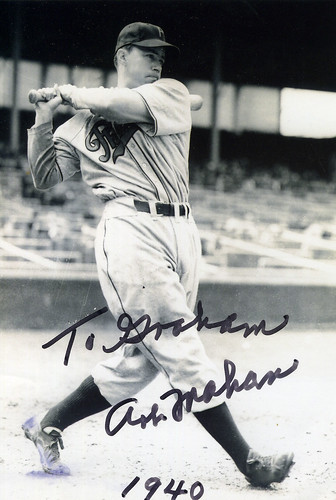I’ve been as guilty as the next guy these past few weeks whining and griping about the money being shelled out for free agents, the leadership of commissioner Bud Selig, the haves getting richer and the have nots getting poorer, and a bunch of not so happy other baseball stuff. M Nor am I normally a nostalgic person but something about the cold weather, the snow, living in a hockey mad country and getting older has given me pause for thought recently. Despite my often quick to criticize attitude, I dearly love the game of baseball.
It began when I was six years old when the only game of the week was every third Saturday and was always the Yankees and always in French. A friend of mine was moving to Germany and he had an extensive collection of baseball cards which he, for reasons best known to him, decided that he would give to me. Those images leapt off the tiny pieces of cardboard, the statistics a foreign language to me. I would remove my baseball cards from their boxes and gaze longingly at the pictures of my heroes and imagine their exploits as only a child could. Baseball magazines were few and far between then, especially during the long offseason, and the local paper, such as it was, were want to cover baseball during the season, let alone the cold winter months.
Baseball was something that seemed to be mine and mine alone and my little insignificant transistor radio was my lifeline to the sounds if not the sights of major league baseball. The World Series was in October then and during the day, making my school days especially impossible to focus as I knew I was missing the games and could only imagine from newspaper accounts what they really looked, felt, sounded and smelled like. I had no idea if what I imagined was anything like the real thing but that was all I had to sustain me. I felt like the kid who loved jazz and didn’t like the rock and roll that all of his friends listened to each night-baseball was my secret almost forbidden pleasure.
Then the most wonderful thing possible happened in 1969, the Montreal Expos came into existence. Montreal was only a two hour drive and my father, God bless his soul, acquiesced a few times a year to my constant pleadings and while he wasn’t a fan and didn’t enjoy the game, would give me bus fare, some money for a bleacher seat, hot dogs and a drink, and send me on my way. My first major league game I was able to see only the centre fielder, (Adolpho Phillips), and the Cubs defeated us 10-9. I have that old tattered scorecard somewhere I think but every play is still in my mind and my first major league hot dog tasted better than anything I have eaten before or since. I wasn’t in heaven; I was in a place well beyond and above.
Each subsequent game saw my arrival at least four hours before the game began, (often the gates weren’t open yet but I always found a sympathetic security guard who would let me in as long as I was quiet. Sometimes I was able to see the players arrive on the team but but I was too much in awe to even think of asking for an autograph. There was so and so in street clothes-it never occurred to me that baseball players wore anything but their uniforms or that they ate or drank like the rest of us mere mortals. They didn’t walk on water it seemed, but put one foot in front of the other as we did.
Many years later I had the opportunity to cover the Triple A Ottawa Lynx for a website in Baltimore and then a website in Philadelphia. After each game it was my “job” to conduct clubhouse interviews and ask pertinent baseball questions to professional baseball players. I would return home after each game looking once again as the game before, “Like a six year old who had been given free reign of the local candy store”. My wife would shake her head but I knew she understood.
The Ottawa Lynx and Montreal Expos are no more and I can manage only a once or twice yearly visit to Syracuse or Pittsburgh. Those visits are more than special to me. Investors and card companies have taken the joy out of collecting of baseball cards but I still have a few boxes in the closet, digging them out on a cold winter’s day to sort them and look at them once again. MLB tv.com has come to my rescue for the past three season, allowing me to watch the game(s) of my choice from March 1st until the end of the World Series.
My little transistor radio has long disappeared and I still seldom meet someone to just sit and talk baseball. I think maybe that’s what writing about the love of my life is really all about, a subconscious connection to my baseball past and a chance to keep living that impossible dream.
